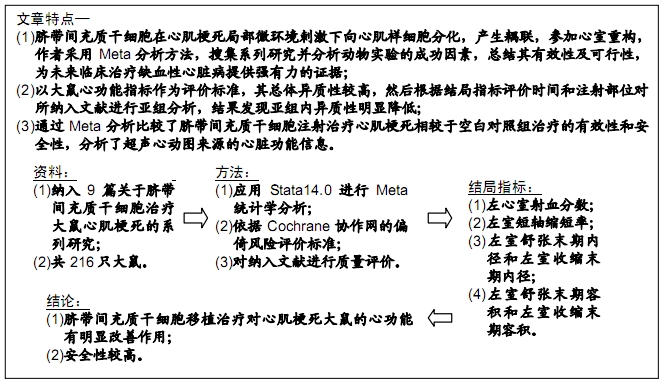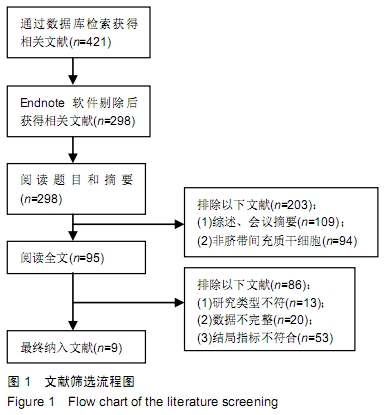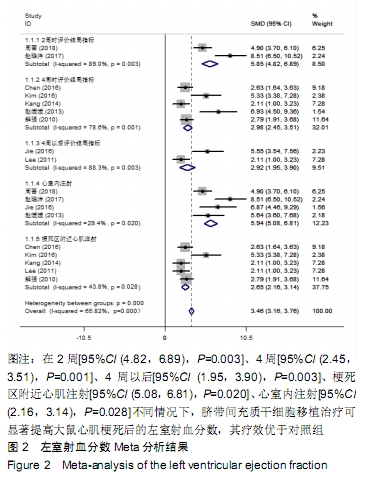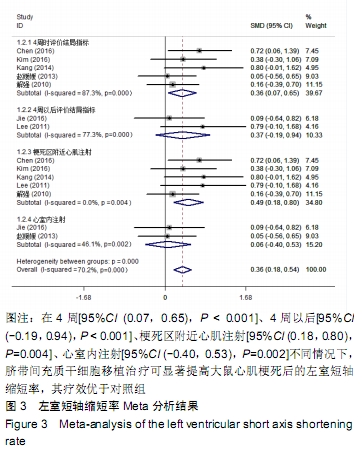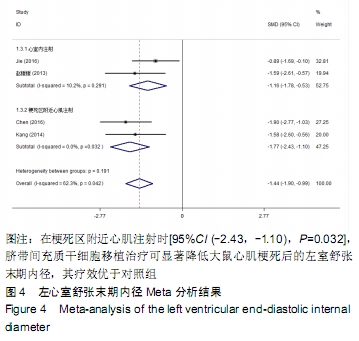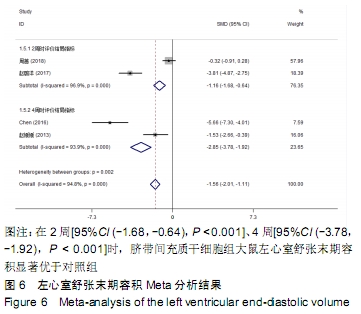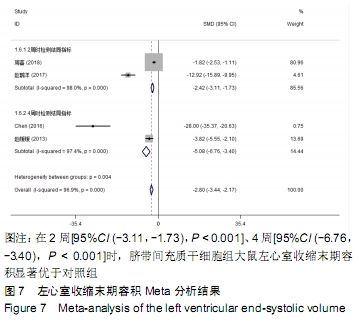[1] HUU AL, PRAKASH S, SHUM-TIM D. Cellular cardiomyoplasty: current state of the field. Regen Med. 2012;7(4):571-582.
[2] BENJAMIN EJ, BLAHA MJ, CHIUVE SE, et al. Heart Disease and Stroke Statistics-2017 Update: A Report From the American Heart Association. Circulation. 2017;135(10):e146-e603.
[3] BURNS RJ, GIBBONS RJ, YI Q, et al. The relationships of left ventricular ejection fraction, end-systolic volume index and infarct size to six-month mortality after hospital discharge following myocardial infarction treated by thrombolysis. J Am Coll Cardiol. 2002;39(1):30-36.
[4] 胡盛寿,高润霖,刘力生,等.《中国心血管病报告2018》概要[J].中国循环杂志,2019,34(3):209-220.
[5] LIU H, PAUL C, XU M. Optimal Environmental Stiffness for Stem Cell Mediated Ischemic Myocardium Repair. Methods Mol Biol. 2017;1553:293-304.
[6] TURKSEN K. Adult stem cells and cardiac regeneration. Stem Cell Rev Rep. 2013;9(5):537-540.
[7] KOUDSTAAL S, JANSEN OF LORKEERS SJ, GAETANI R, et al. Concise review: heart regeneration and the role of cardiac stem cells. Stem Cells Transl Med. 2013;2(6):434-443.
[8] MU J, LI X, YUAN S, et al. Directional differentiation of human embryonic stem cells into cardiomyocytes by direct adherent culture. Journal of Histotechnology. 2014;37(4):125-131.
[9] LI J, ZHU K, WANG Y, et al. Combination of IGF‑1 gene manipulation and 5‑AZA treatment promotes differentiation of mesenchymal stem cells into cardiomyocyte‑like cells. Mol Med Rep. 2015;11(2):815-820.
[10] JUMABAY M, MATSUMOTO T, YOKOYAMA S, et al. Dedifferentiated fat cells convert to cardiomyocyte phenotype and repair infarcted cardiac tissue in rats. J Mol Cell Cardiol. 2009; 47(5):565-575.
[11] WEGENER M, BADER A, GIRI S. How to mend a broken heart: adult and induced pluripotent stem cell therapy for heart repair and regeneration. Drug Discov Today. 2015;20(6):667-685.
[12] HONG KU, BOLLI R. Cardiac stem cell therapy for cardiac repair. Curr Treat Options Cardiovasc Med. 2014;16(7):324.
[13] NATSUMEDA M, FLOREA V, CASTELLANOS AM, et al. The Combination of Allogeneic Mesenchymal Stem Cells and Cardiac Stem Cells Produce Synergistic Effects in Cardiac Regeneration. Circulation. 2016;134:A19681.
[14] KIM JT, CHUNG HJ, SEO JY, et al. A fibrin-supported myocardial organ culture for isolation of cardiac stem cells via the recapitulation of cardiac homeostasis. Biomaterials. 2015;48:66-83.
[15] ZHENG SX, WENG YL, ZHOU CQ, et al. Comparison of cardiac stem cells and mesenchymal stem cells transplantation on the cardiac electrophysiology in rats with myocardial infarction. Stem Cell Rev Rep. 2013;9(3):339-349.
[16] MUSIALEK P, MAZUREK A, JAROCHA D, et al. Myocardial regeneration strategy using Wharton's jelly mesenchymal stem cells as an off-the-shelf 'unlimited' therapeutic agent: results from the Acute Myocardial Infarction First-in-Man Study. Postepy Kardiol Interwencyjnej. 2015;11(2):100-107.
[17] XIONG ZH, WEI J, LU MQ, et al. Protective effect of human umbilical cord mesenchymal stem cell exosomes on preserving the morphology and angiogenesis of placenta in rats with preeclampsia. Biomed Pharmacother. 2018;105:1240-1247.
[18] SHELTON E, ALLEGRETTI JR, STEVENS B, et al. Efficacy of Vedolizumab as Induction Therapy in Refractory IBD Patients: A Multicenter Cohort. Inflamm Bowel Dis. 2015;21(12):2879-2885.
[19] WAN M, CUI S, WEI W, et al. Bi-component synergic effect in lily-like CdS/Cu,7,S,4,QDs for dye degradation. Rsc Adv. 2019; 9(5): 2441-2450.
[20] REYNOLDS K, GO AS, LEONG TK, et al. Trends in Incidence of Hospitalized Acute Myocardial Infarction in the Cardiovascular Research Network (CVRN). Am J Med. 2017;130(3):317-327.
[21] JUN Y, CHUNJU Y, QI A, et al. The effects of compound danshen dripping pills and human umbilical cord blood mononuclear cell transplant after acute myocardial infarction. Exp Clin Transplant. 2014;12(2):123-128.
[22] LI T, MA Q, NING M, et al. Cotransplantation of human umbilical cord-derived mesenchymal stem cells and umbilical cord blood-derived CD34⁺ cells in a rabbit model of myocardial infarction. Mol Cell Biochem. 2014;387(1-2):91-100.
[23] LUNDH A, GØTZSCHE PC. Recommendations by Cochrane Review Groups for assessment of the risk of bias in studies. BMC Med Res Methodol. 2008;8:22.
[24] 周蔷,邢燕.疏血通注射液联合心室内注射人脐带间充质干细胞对急性心肌梗死大鼠心功能的影响及机制探讨[J].河北中医,2018, 40(11):1709-1713.
[25] 赵璐洋,孙瑛,李连冲.心室内注射人脐带间充质干细胞改善心肌梗死大鼠心功能及作用机制[J].中国组织工程研究, 2017,21(25):4026-4031.
[26] CHEN G, YUE A, YU H, et al. Mesenchymal Stem Cells and Mononuclear Cells From Cord Blood: Cotransplantation Provides a Better Effect in Treating Myocardial Infarction. Stem Cells Transl Med. 2016;5(3):350-357.
[27] MA J, ZHAO Y, SUN L, et al. Exosomes Derived from Akt-Modified Human Umbilical Cord Mesenchymal Stem Cells Improve Cardiac Regeneration and Promote Angiogenesis via Activating Platelet-Derived Growth Factor D. Stem Cells Transl Med. 2017;6(1):51-59.
[28] KIM SW, JIN HL, KANG SM, et al. Therapeutic effects of late outgrowth endothelial progenitor cells or mesenchymal stem cells derived from human umbilical cord blood on infarct repair. Int J Cardiol. 2016;203:498-507.
[29] KANG BJ, KIM H, LEE SK, et al. Umbilical-cord-blood-derived mesenchymal stem cells seeded onto fibronectin-immobilized polycaprolactone nanofiber improve cardiac function. Acta Biomater. 2014;10(7):3007-3017.
[30] 赵媛媛,曹文明,马洁, 等.构建大鼠急性心肌梗死模型并初步探讨人脐带间充质干细胞的修复作用[J].临床检验杂志,2013, 31(12):919-922.
[31] LEE EJ, CHOI EK, KANG SK, et al. N-cadherin determines individual variations in the therapeutic efficacy of human umbilical cord blood-derived mesenchymal stem cells in a rat model of myocardial infarction. Mol Ther. 2012;20(1):155-167.
[32] 解强,江宏伟,白雪涛, 等.人脐血干细胞移植治疗大鼠心肌梗死的实验研究[J].成都医学院学报,2010,5(1):39-42.
[33] KELLE S, ROES SD, KLEIN C, et al. Prognostic value of myocardial infarct size and contractile reserve using magnetic resonance imaging. J Am Coll Cardiol. 2009;54(19):1770-1777.
[34] VELAGALETI RS, PENCINA MJ, MURABITO JM, et al. Long-term trends in the incidence of heart failure after myocardial infarction. Circulation. 2008;118(20):2057-2062.
[35] WOLLERT KC, DREXLER H. Cell therapy for the treatment of coronary heart disease: a critical appraisal. Nat Rev Cardiol. 2010;7(4):204-215.
[36] WANG G, ZHAO Q, CHENG Q, et al. Comparison short time discharge with long time discharge following uncomplicated percutaneous coronary intervention for Non-ST elevation myocardial infarction patients. BMC Cardiovasc Disord. 2019; 19(1):109.
[37] WRITING GROUP MEMBERS, LLOYD-JONES D, ADAMS RJ, et al. Heart disease and stroke statistics--2010 update: a report from the American Heart Association. Circulation. 2010;121(7):e46-e215.
[38] HASIN T, GERBER Y, WESTON SA, et al. Heart Failure After Myocardial Infarction Is Associated With Increased Risk of Cancer. J Am Coll Cardiol. 2016;68(3):265-271.
[39] 王巍,李肖甫,李中健.不同孕周人脐带间充质干细胞移植改善心肌梗死模型心脏功能的比较[J].中国组织工程研究,2016,20(6):799-806.
[40] TAKIZAWA S, NAGATA E, NAKAYAMA T, et al. Recent Progress in Endothelial Progenitor Cell Culture Systems: Potential for Stroke Therapy. Neurol Med Chir (Tokyo). 2016;56(6):302-309.
|
